Over the past couple of weeks Southern rust in corn has been reported in the Mid-South. Both Southern rust and common rust have been reported in Tennessee fields, but only Southern rust poses a threat to yield.
Both rusts have similar fungal structures such as raised lesions called pustules which rupture the epidermal leaf tissue to produce masses of spores. Rust spores can be wiped off leaves and may leave an orange or brown stain on fingers or clothing. The characteristics that differ between the rusts are the location, color, shape, and distribution of pustules (Table below and images at end of post).
| Pustule Characteristics: | Common Rust | Southern Rust |
| Location | upper and lower leaf surfaces | primarily upper leaf surface |
| Color | brownish, red | orange to light brown |
| Shape | elongated | round |
| Distribution | scattered | densely packed |
| Other differences: | ||
| Optimal Temperature | 61-77 °F | 77-82 °F |
| Probability of Effecting Yield | low | moderate |
Another difference between the rusts is the optimal temperatures for infection and development: common rust is more of a cool weather pathogen (61-77 °F) whereas Southern rust prefers warmer weather (77-82 °F). This explains why common rust is usually seen earlier in the growing season than Southern rust which can appear later in August or September.Both rusts may first be observed in upper canopies or clustered on leaves from infections that occurred while leaves were in the whorl. Mixed infections of both rust fungi can occur on the same plant, which can confuse diagnosis. Both rust require living plant tissue to survive and hence once the corn plant dies the fungus loses its host and cannot survive over the winter in Tennessee. Each year, spores of both rusts are blown north from more tropical areas. Short periods of leaf wetness (approximately 6 hours of dew) provide enough moisture for infection and disease development. While common rust usually does not affect yield, Southern rust may have a negative impact on yield. Factors that influence the impact Southern rust may have on yield include, weather, growth stage of corn, yield potential, amount of disease in field, and susceptibility of hybrid. If southern rust is present before the soft dough stage (35 days before maturity) a fungicide application may be beneficial, while corn that is in the dent growth stage will most likely not benefit from a fungicide application. Fungicides for managing Southern rust can be found at UTcrops.com (Corn Fungicide List).

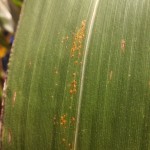
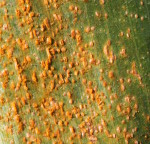
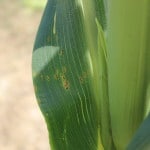
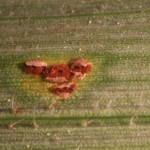

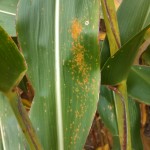
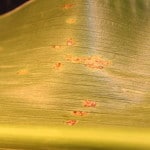
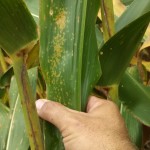

I noticed Headline has an “E” on southern rust, would that be preventive only? We have some rust present in some later corn and considering treatment. And what about a Folicur replacement, no rating? Thanks
David,
Thank you for the very good questions. On fungicides as a ‘preventative’ or ‘curative’, solo strobilurin/QoI products (such as Headline) are known to particularly affect spore germination (true fungi pathogens) and spore motility (Phytophthora and Pythium pathogens), but they can also have some ‘curative’ activity against some diseases. In general, it is recommended to apply strobilurin/QoI fungicides prior to infection or in the early stages of disease development in order to capitalize on their effects against spore germination. Triazole/DMI fungicides have more of a ‘curative’ effect because of their effect on stopping further infection, but they lack efficacy against spores; although there are exceptions to this. So when disease is present in a field, particularly rusts, the best fungicide application is a combination of a strobilurin/QoI and a triazole/DMI fungicide.
The Folicur (tebuconazole) product has not been tested enough against Southern rust to have sufficient data to say whether it has good control or not. As more data is collected that spot on the corn fungicide table will be updated.
Heather